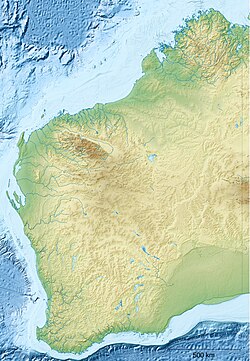| Colalura Sandstone | |
|---|---|
| Stratigraphic range: middle Bajocian ~ | |
| Type | Geological formation |
| Unit of | Champion Bay Group |
| Underlies | Bringo Shale, Newmarracarra Limestone [1] |
| Overlies | Moonyoonooka Sandstone |
| Thickness | Maximum 8.5 m (28 ft) |
| Lithology | |
| Primary | Sandstone, conglomerate |
| Other | Claystone, siltstone, shale |
| Location | |
| Coordinates | 28°42′S114°48′E / 28.7°S 114.8°E |
| Approximate paleocoordinates | 39°48′S57°30′E / 39.8°S 57.5°E |
| Region | Western Australia |
| Country | Australia |
| Extent | Perth Basin |
The Colalura Sandstone is a Middle Jurassic geologic formation of the Perth Basin of Western Australia. The formation overlies the Moonyoonooka Sandstone. [2]
Contents
Dinosaur remains have been recovered from the formation. [3]

